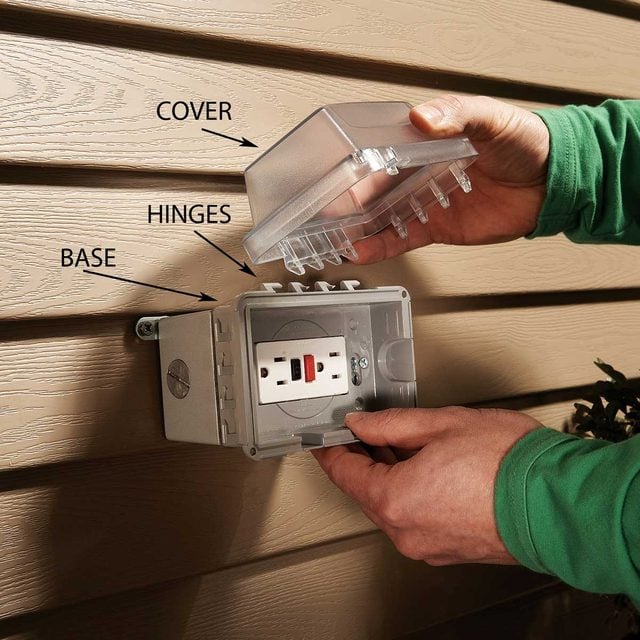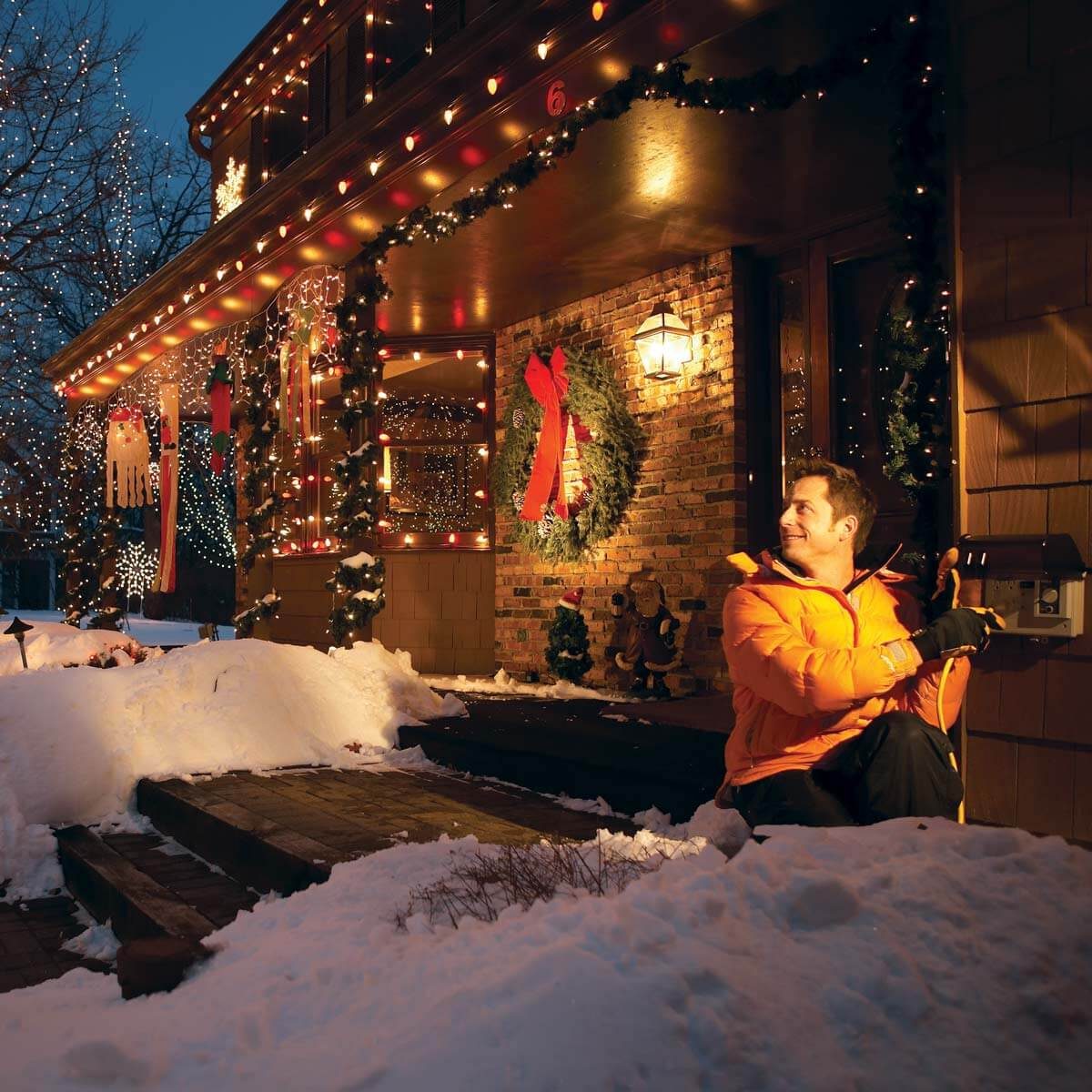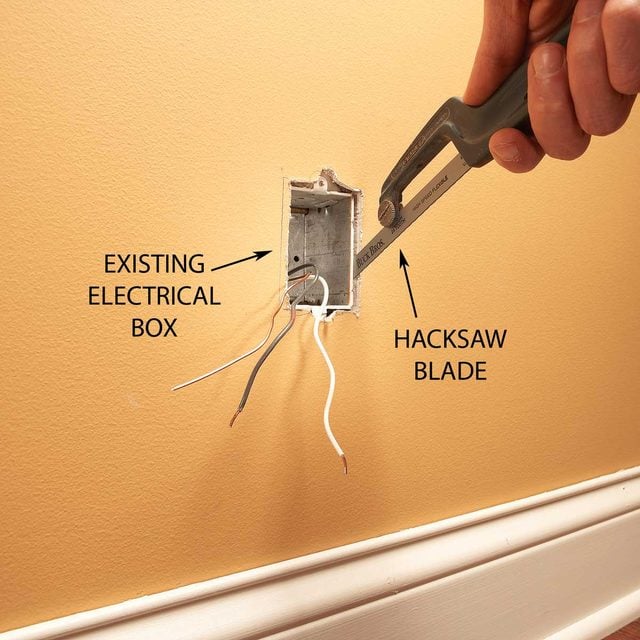Install an Exterior Outlet
A full day
Beginner
$51–100
Introduction
Add an outdoor electrical outlet to get power to where you need it, especially for holiday lights. Do it safely and easily with this simple through-the-wall technique.Tools Required
- 1-in. drill bit
- 1/4-in. drill bit
- 4-in-1 screwdriver
- Drill/driver - cordless
- Electrical tape
- File
- Fish tape
- Hammer
- Non-contact voltage tester
- Stud finder
- Wire coat hanger
- Wire stripper/cutter
Materials Required
- Cable clamps
- Electrical cable
- Exterior electrical box
- GFCI outlet
- Silicone caulk
- Weatherproof box cover
- Wire connectors
Project step-by-step (10)
Step 1
Choose and Mark the Outlet Location
- To keep this project simple, place the new outlet in the same stud cavity as an existing indoor outlet.
- Start by choosing the interior outlet you want to use.
- Building codes prohibit tapping into circuits in the kitchen, bathroom, laundry room or into those dedicated to a large appliance, like a refrigerator. You can use the living room, bedroom and basement circuits, but don’t tap into a circuit that’s already overloaded and trips the circuit breaker.
- To place the outlet somewhere other than opposite the interior outlet, see “Running Cable From Other Power Sources” below. Here are a few tips for running an outdoor electrical wire.
- Building codes prohibit tapping into circuits in the kitchen, bathroom, laundry room or into those dedicated to a large appliance, like a refrigerator. You can use the living room, bedroom and basement circuits, but don’t tap into a circuit that’s already overloaded and trips the circuit breaker.
Step 2
Turn Off the Power
- Turn off the circuit breaker controlling the outlet.
- Use a non-contact voltage tester to be sure the power is off.
- Unscrew and pull the receptacle out of the electrical box.
- Hold the voltage tester over the terminals to double-check that the power is off.
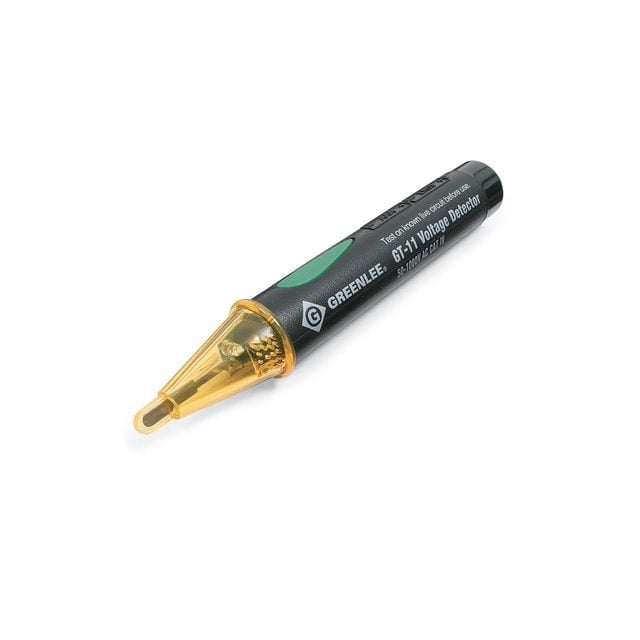
Step 3
Adjust the Wires
- Next, unscrew the wires from the outlet.
- Make sure the junction box is large enough to hold an added set of wires.
- An overstuffed box is a fire hazard.
- If the box is plastic, shine a flashlight inside and look for a volume listing, such as 21 cu. in. (cubic inches).
- Pro tip: If your box is metal, we recommend replacing it (see below). Most metal boxes are too small to hold additional wires.
Step 4
Drill Through the Exterior Wall
- Use a stud sensor to determine which side of the electrical box the stud is on.
- Place a 1/4- x 18-in.-long drill bit along the outside of the electrical box on the side away from the stud.
- Squeeze the bit between the box and the drywall.
- Don’t worry if you make a small hole in the drywall. You can hide it later with the outlet cover plate.
- Drill through the wall and through the siding to mark the location for the new outlet.
- We tilted the drill bit downward to lower the outlet location (if it’s near the ground you can hide it behind shrubs), but you can place it anywhere on the wall.
- Go outside and drill a 3/4-in. hole in the siding over or near the smaller hole.
- If that’s not where you want the exterior junction box located, move it straight up or down (staying in the same stud cavity) and mark the position of the box hole on the siding. Then drill a one-inch hole over the smaller hole or the mark on the siding to make room for the cable.
- If drilling through stucco, you’ll probably wreck the bit, but you’ll get through the siding. For brick, use a masonry drill bit with a hammer drill. Then drill a series of small-diameter holes around the marker hole and knock out the center with a hammer and chisel.
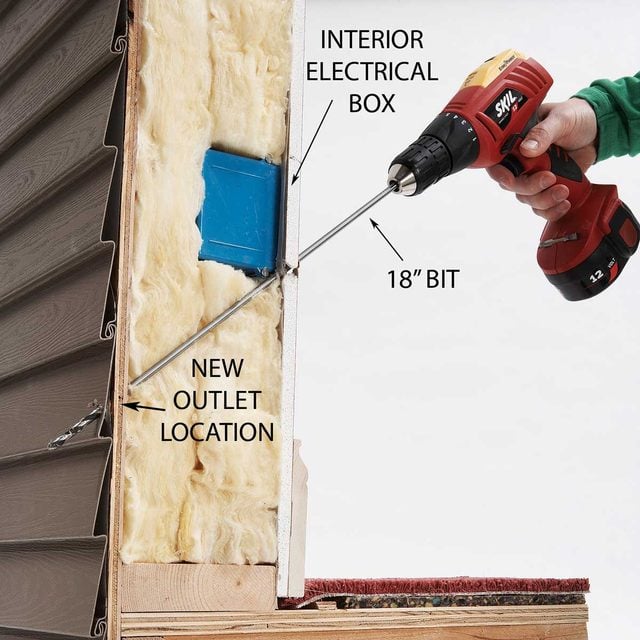
Step 5
Run Cable From Other Power Sources
- If you want your exterior outlet somewhere without a convenient interior outlet, you’ll have to tap into another electrical circuit.
- Option One: If you have an unfinished basement, you can tap into a junction box in the basement and run the cable out through the rim joist.
- This is even easier than tapping into a main floor outlet. Plus it allows you to put your new outlet anywhere, not just opposite an interior outlet.
- Simply drill a hole through the rim joist and siding, then run a cable from a basement light fixture to the outlet location.
- Option Two: Run wires inside 1/2-in. metal conduit from an existing exterior outlet to the new location.
- The conduit can wrap around corners with a service ell, but don’t run it in front of doors.
- Plant flowers or shrubs in front to cover it.
- If you have aluminum wiring, call in a licensed electrician who is certified to work with it. This wiring is dull gray, not the dull orange that is characteristic of copper wire.
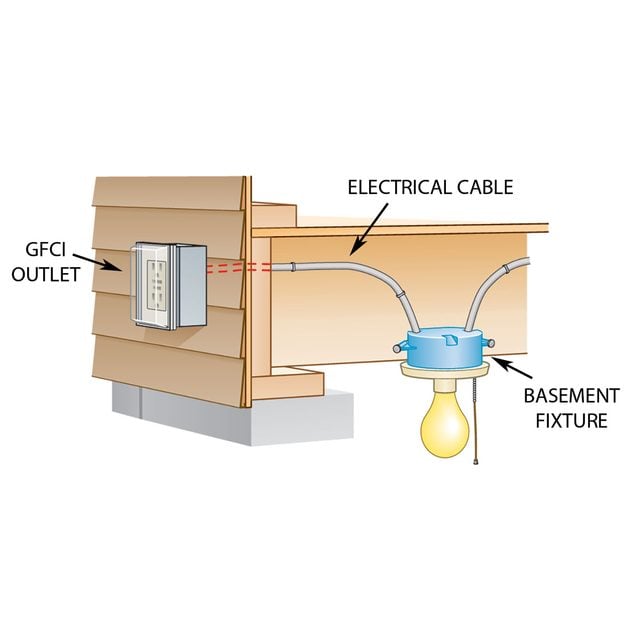
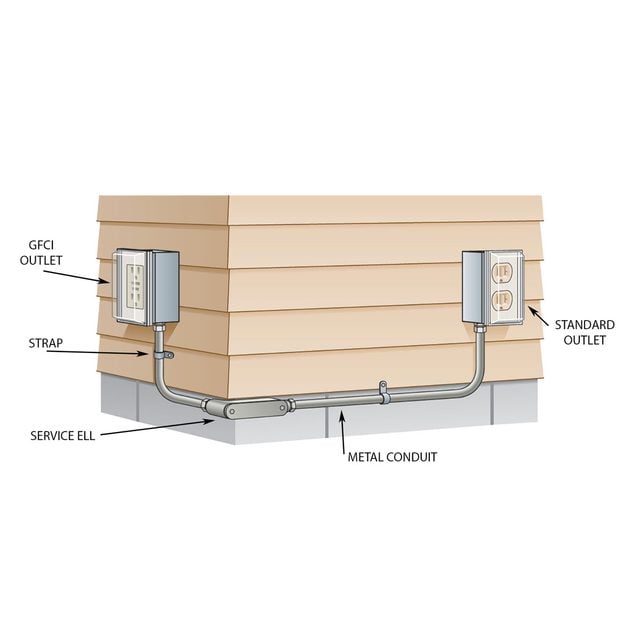
Step 6
Run Cable Between the Outlets
- The new wire must be the same gauge (thickness) as the wire already in the box, which is most likely 14 gauge but could be 12.
- To check, use the labeled notches on wire-stripper pliers.
- Run a cable from the interior box to the hole in the exterior.
- Start by removing a knockout in the box by hitting it with a screwdriver.
- Then strip about two feet of sheathing off the end of the cable and cut off two of the three wires.
- Tape the end of the remaining wire to the end of the sheathing, forming a loop.
- Feed the loop through the knockout into the wall cavity.
- Bend the end of a wire coat hanger to form a hook.
- Insert it through the hole in the exterior, grab the wire loop in the wall and pull it back through the hole.
- Pull through at least 12 in. of cable to give yourself plenty to work with.
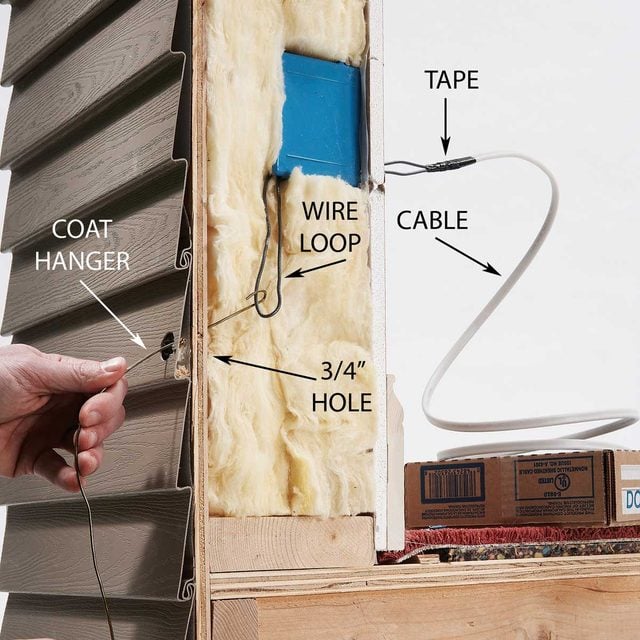
Step 7
Replace an Electrical Box
- If your existing electrical box isn’t large enough to hold more wires, you’ll have to replace it.
- Remove the old box before cutting a large opening for the new one. This allows you to see if anything is behind the wall before you make the cut.
- To swap out boxes, cut the nails that hold the box in place.
- Then remove the box.
- Replace it with a plastic “remodeling” box.
- These boxes have wings that flip up and attach to the back side of the drywall or plaster.
- Hold the box over the wall opening and trace around it.
- Then enlarge the opening with a drywall saw.
- Don’t overcut; you want a snug fit.
- Feed the new cable from the outlet being added into the box before installing it.
- Wrap the cable with electrical tape where the sheathing meets the exposed wires so the sheathing will slide into the box easier.
Step 8
Wire the Interior Outlet
- At the interior box, cut the cable so there’s 12 in. sticking out, then remove the sheathing to expose the wires.
- Cut six-inch pieces of wires from the coil and strip 3/4 in. of insulation off the ends.
- Fasten the pigtail wires to the outlet, then join the wires with wire connectors. The bare copper goes to the ground screw (green), the white to either of the silver terminals, and the black to either of the brass screws on the other side.
- Hook the wires clockwise over the screws so they stay in place as you tighten the screws.
- To wire the interior outlet, connect all the hot wires (black and any other color except green or white), all the neutral wires (white) and all the ground wires (green or bare copper.
- Gently fold the wires into the box, then reattach the outlet and cover plate. If you damaged the wall around the box, use an oversize cover plate to hide the problem.

Step 9
Mount and Wire the New Outlet
- Attach a clamp to the box, feed the cable through it into the box, then caulk around the clamp.
- The caulk makes the hole watertight. We placed our box horizontally on the lap siding so it could lie flat.
- Mount the exterior outlet box to the house.
- If you have lap siding (wood, hardboard, fiber cement) or plywood sheathing, mount the junction box to the house, using exterior-grade fasteners. Simply drive galvanized deck screws through the mounting lugs. For brick or stucco siding, mount the box with masonry anchors. For vinyl siding over composition board, use hollow wall anchors.
- Fasten plugs into the openings on both ends of the box.
- Use a file to scrape a small notch or “weep hole” in the bottom edge of the box. This allows any water that gets into the box to drain.
- Next, strip the insulation off the wire ends.
- Attach the ground wire to the green screw in the box and to the green screw on the GFCI outlet. Make sure to identify the line, hot and white terminals (they’ll be labeled “line,” “hot” and “white”). Attach the black wire to the brass screw or adjacent push-in hole (labeled “line”) and the white wire to the silver screw or push-in.
- Clip the ears off the outlet, fold the wires into the box and set the outlet in place.
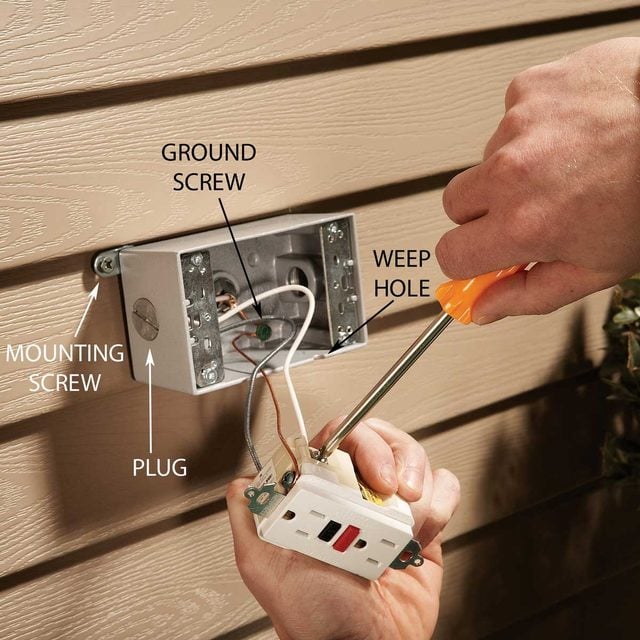
Step 10
Mount the Weatherproof Electrical Outlet Box Cover
- You’ll need to remove the middle of the plastic cover base so it’ll fit over the GFCI outlet (don’t worry, it’s designed to come out by twisting it with pliers).
- Set the base on the box, over the outlet.
- Make sure the hinges are at the top so the plastic cover will close over the outlet.
- Fasten the base to the box with the screws that came with the kit.
- Attach the cover to the base.
- Push the hinge receptacles sideways over the hinges until they snap in place.
- Remove the cord knockouts in the base where the electrical cords will run.
- Turn the power on and plug in your miles of holiday lights!
